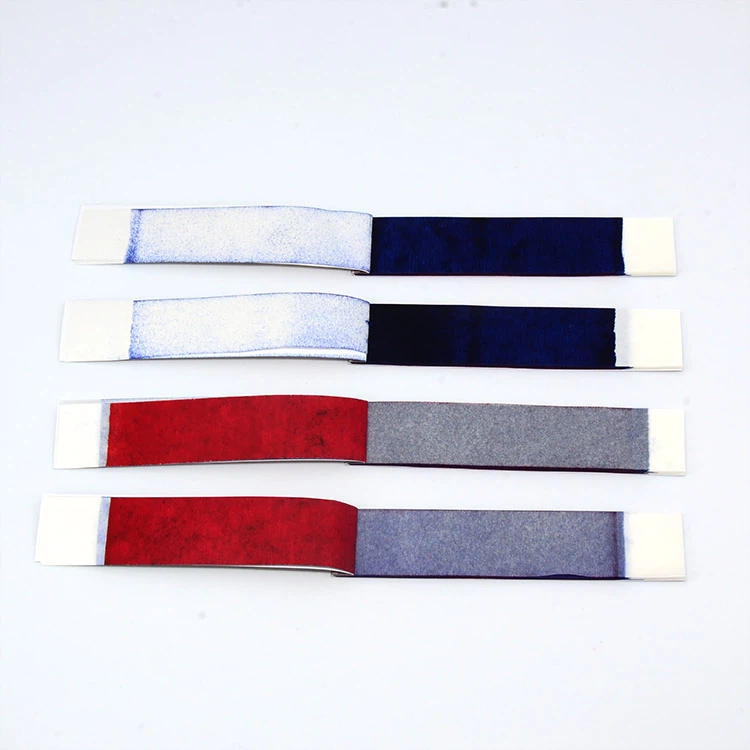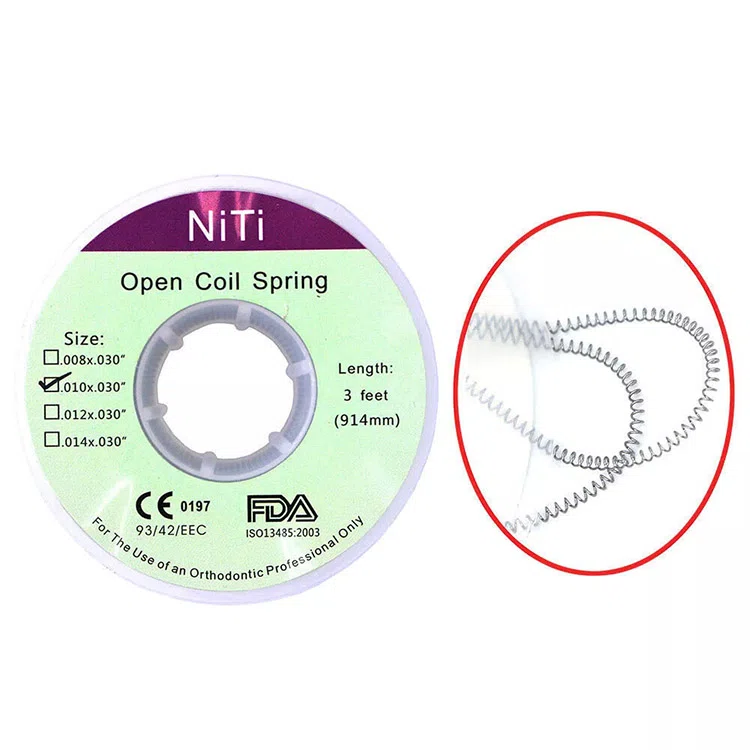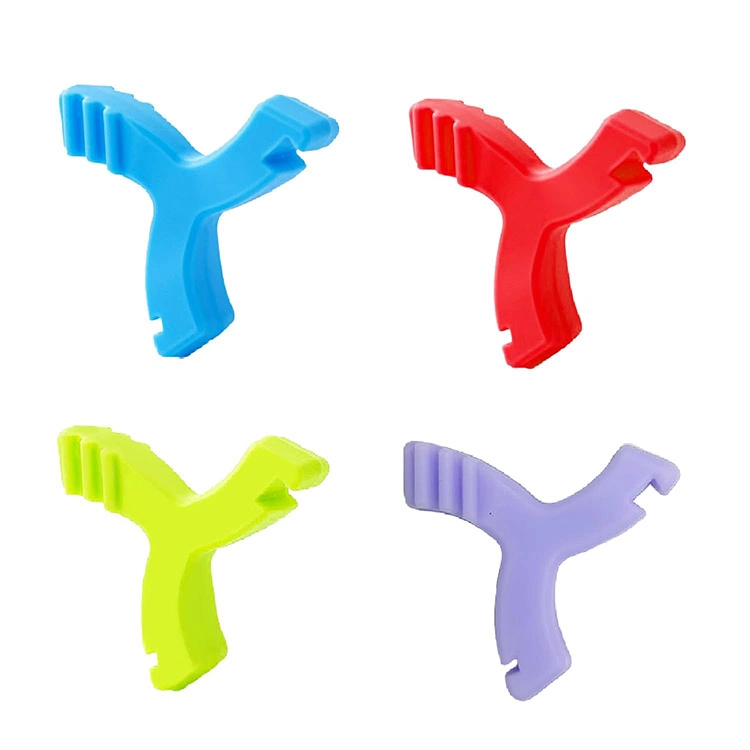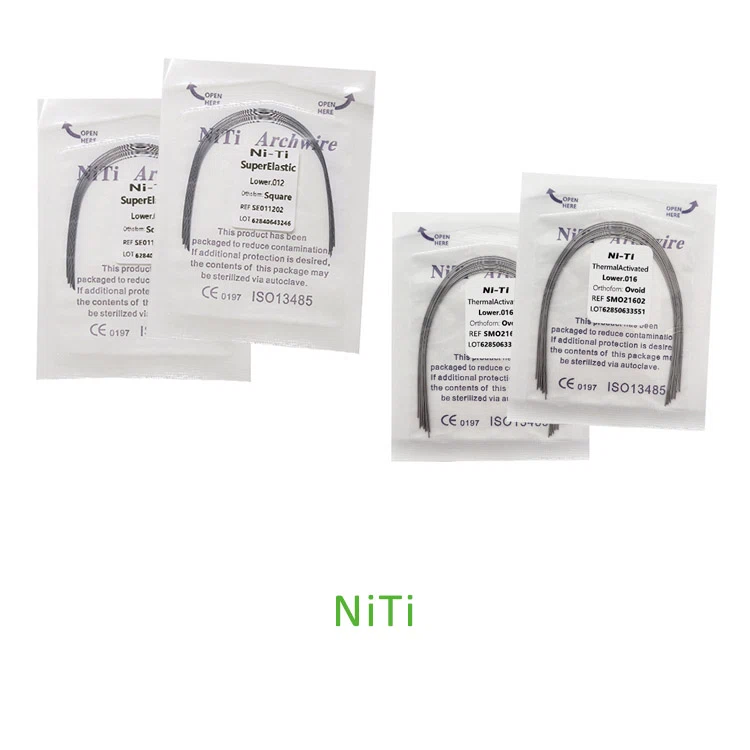
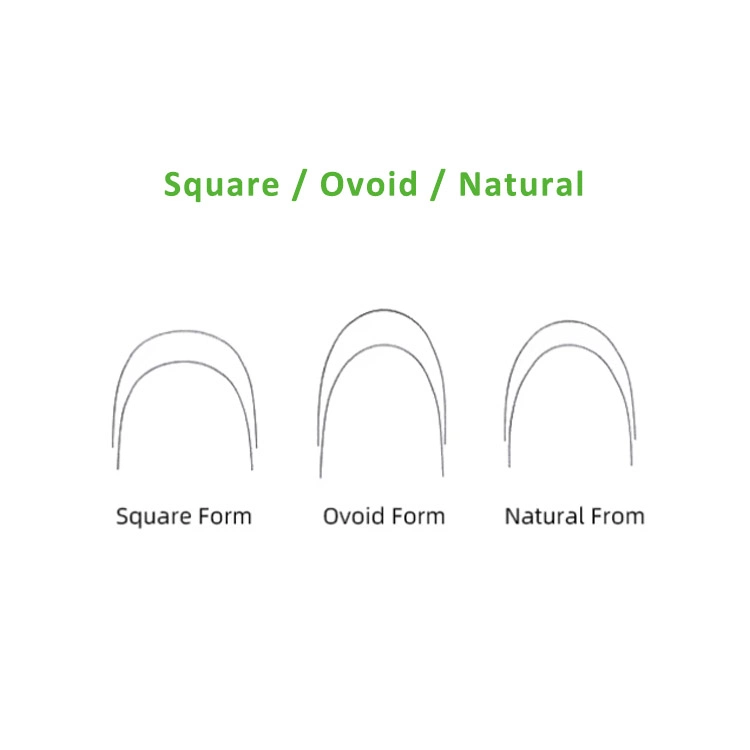
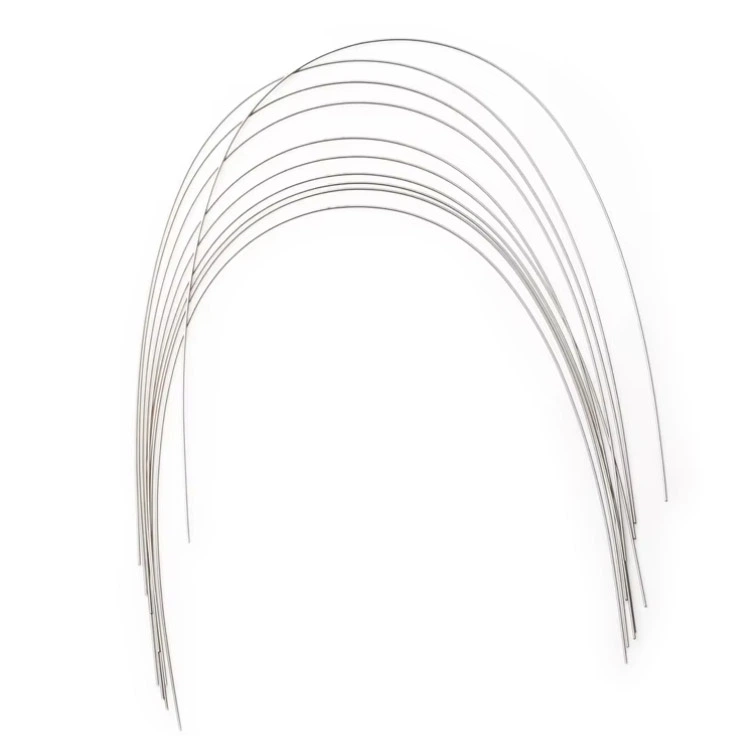
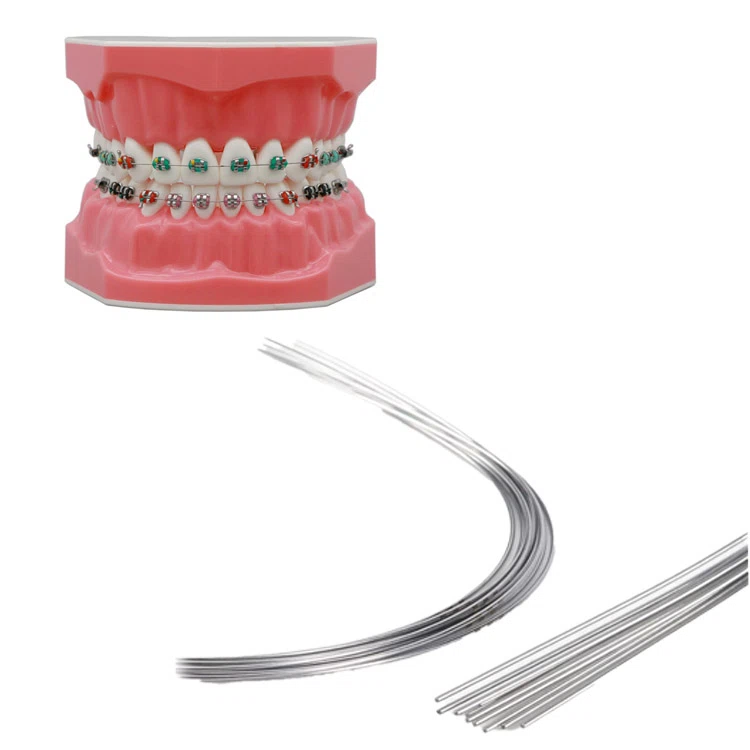
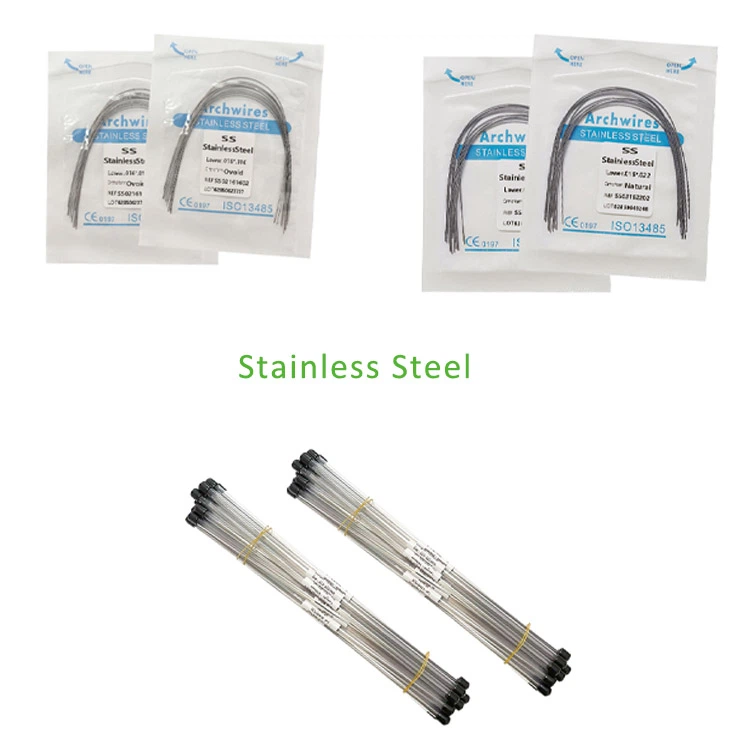
Ортодонтическая арка проволока
- Нити / Провод арки из нержавеющей стали
- упаковка: 10ПК/Пакет
- Выставки отличной весны
- Последовательная производительность
- Высокополирован для уменьшения трения
- Полный размер серии и тип формы для выбора
Провод ортодонтической арки оказывает давление на зубы, чтобы побудить их перемещаться в назначенное положение. Обычно используется в сочетании с брекетами, и регулируя натяжение и направление ортодонтического провода, Это может эффективно улучшить выравнивание зубов и проблемы с укусом.
Провода ортодонтических арх применяют световое непрерывное напряжение на точки поддержки и привязки на зубах. Эти зубы будут двигаться тонко, но постепенно в течение длительного периода времени, переходить в желаемые позиции. Результатом ортодонтического лечения является выравнивание зубов, Симметричные зубные арки, и уменьшение тонкости между зубами, который меняет контур лица, сделать его более гармоничным и эстетически приятным. Ортодонтические арки провода выпрямляют зубы и улучшают способность жевать с лучшим укусом.
Категория ортодонтических арх -проводов
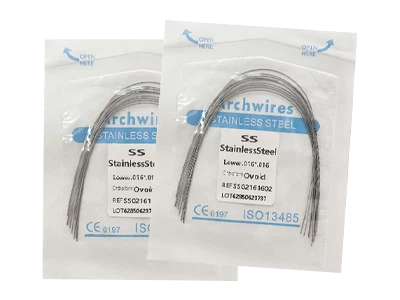
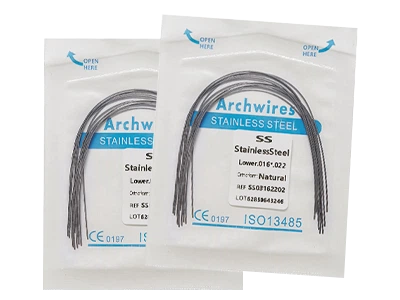
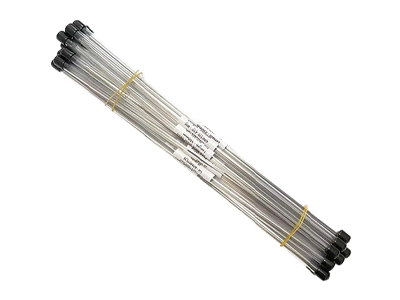
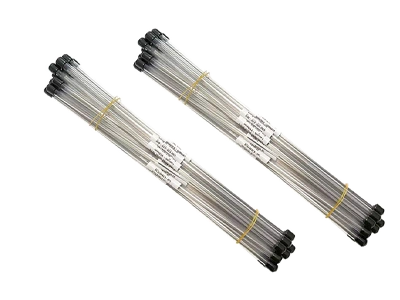
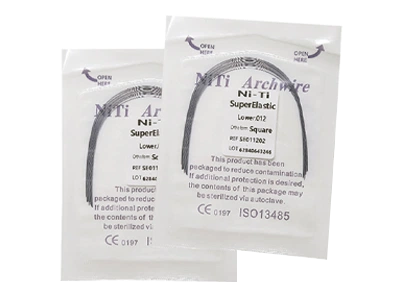
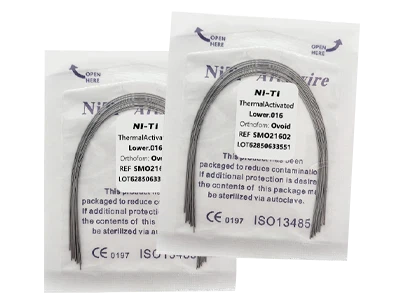
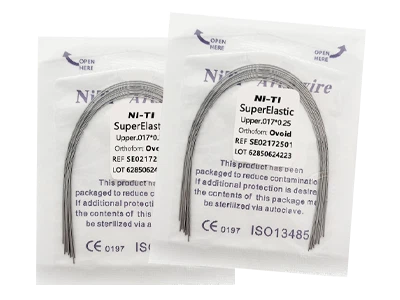
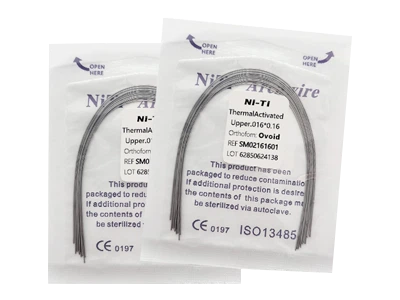
На основании материального состава, Наши ортодонтические архии могут быть классифицированы как провода из нержавеющей стали и провода NITI. В то время как арка из нержавеющей стали дешевая, имеет хорошее истирание и коррозионное сопротивление и надолго стабильности в полости рта, Твердость высока, Не так удобно, как провода NITI, и низко на эластичности. Провод Arch Niti Super Elastic и имеет функцию памяти формы. Это более гибко, позволяя ему лучше вписаться на поверхность зуба, таким образом, делает его более комфортным, но по более высокой цене.
Связанные продукты
Определение ортодонтических дуг
Ортодонтическая дуга является ключевым компонентом ортодонтического лечения полости рта.. Это тонкий проволочный материал с особыми механическими свойствами., в основном передача ортодонтической силы через брекет-систему дуги, содействие медленному движению зубов и корректировке окклюзионных отношений. На протяжении всего процесса лечения, ортодонтические проволоки играют двойную роль: “проводник силы” и “зубной проводник”, и их эффективность напрямую влияет на ортодонтический результат, продолжительность лечения, и комфорт пациента.
Ортодонтические дуги обычно изготавливаются из металлических сплавов., например, проволока из нержавеющей стали, состоящая из железа, хром, и никель; проволока из никель-титанового сплава из никеля и титана; и проволоки из бета-титанового сплава с титановой основой, легированной такими элементами, как молибден и ниобий..
Принцип использования ортодонтических дуг
Ортодонтическая дуга точно передает заданную врачом ортодонтическую силу на целевой зуб через соединение с брекетами. (металлические или керамические основы, приклеенные к поверхности зуба, какие аксессуары для ортодонтического лечения), создавая сжимающую силу и тем самым способствуя медленному движению зуба внутри альвеолярной кости. Конечная цель – достижение терапевтической цели выпрямления зубов., координация окклюзионных отношений и улучшение морфологии лица.
Классификация материалов и особенности проволок ортодонтических дуг
1. Проволока из нержавеющей стали
- Композиция: В основном состоит из таких металлов, как железо., хром, и никель (содержание хрома: 17%-19%, содержание никеля: 8%-10%), в некоторые профессиональные продукты также добавляются такие элементы, как молибден и титан, для оптимизации производительности..
- Функции: Высокая сила, большая жесткость, сильная коррозионная стойкость, и менее склонны к ржавчине во влажной среде полости рта. Имеет умеренный модуль упругости., который может обеспечить стабильную ортодонтическую силу и имеет хорошие характеристики обработки. Его можно согнуть в дугу различной формы в соответствии с требованиями лечения..
- Применимый этап: Его часто используют на среднем и поздних этапах ортодонтического лечения., например, точная регулировка после выравнивания зубов и коррекция окклюзионных взаимоотношений., и особенно подходит для случаев с высокими требованиями к ортодонтической эффективности..
2. Проволока из никель-титанового сплава
- Композиция: Сплав с памятью формы, состоящий из никеля. (50%-55%) и титан (45%-50%), В зависимости от кристаллической структуры ее можно разделить на аустенитную никель-титановую проволоку и мартенситную никель-титановую проволоку..
- Функции: Обладает эффектом памяти формы и суперэластичностью., может вернуться к заданной форме при температуре тела, и постоянно обеспечивать мягкую и стабильную корректирующую силу. Имеет низкий модуль упругости., вызывает меньше раздражения зубов, и повышает комфорт пациента.
- Применимый этап: В основном используется на ранней стадии лечения., такие как выровненные зубы и открытая окклюзия, особенно подходит для случаев сильной скученности и перекрута зубов, эффективно снижает дискомфорт пациента.
3. Проволока из титанового сплава (проволока из β-титанового сплава)
- Композиция: Сплавы, образованные добавлением таких элементов, как молибден., ниобий, и цирконий к титану в качестве основного материала. (например, сплав Ti-Mo-Nb-Zr).
- Функции: Он сочетает в себе высокую прочность проволоки из нержавеющей стали с хорошей эластичностью проволоки из никель-титанового сплава., а его модуль упругости находится между двумя. Имеет хорошую биосовместимость и не содержит никеля., что делает его подходящим для пациентов с аллергией на никель. Он обладает сильной коррозионной стойкостью и хорошей производительностью обработки., и может быть изготовлен в виде сложной формы из проволочной дуги..
- Применимый этап: Подходит для среднего этапа ортодонтического лечения., особенно в переходный период от ровных зубов к точной регулировке. Он может не только обеспечить достаточную корректирующую силу, но и обеспечить стабильность движения зубов..
Типы корректирующих сил ортодонтических дуг
По характеру силы, создаваемой проволокой ортодонтических дуг, они в основном подразделяются на следующие типы:
- Упругая сила: Когда дуги ортодонтических дуг подвергаются упругой деформации, создается упругая сила, который является основным источником энергии для перемещения зубов. Проволока из никель-титанового сплава обладает самым щадящим действием., самая стабильная и самая продолжительная сила упругости, в то время как проволока из нержавеющей стали имеет более высокую силу упругости, но относительно меньшую продолжительность.
- Трение: Трение между ортодонтическими дугами и брекетами оказывает существенное влияние на скорость перемещения зубов.. На этапе выравнивания зубов, необходимо максимально минимизировать трение для повышения эффективности движения. На этапе тонкой настройки, соответствующее трение помогает поддерживать стабильное положение зубов.
- Крутящий момент: Крутящая сила, создаваемая изгибом проволоки ортодонтической дуги, может контролировать наклон губ и языка зубов., улучшение окклюзионных взаимоотношений и формы лица. Проволока из титанового сплава обладает хорошей стабильностью крутящего момента и является широко используемым материалом для контроля крутящего момента в клинической практике..
Факторы, влияющие на ортодонтическую силу проволок ортодонтических дуг
- Свойства материала: Модуль упругости, Предел текучести и предел упругости разных материалов различаются., которые непосредственно определяют величину и продолжительность действия корректирующей силы. Например, проволока из никель-титанового сплава имеет низкий модуль упругости, что приводит к относительно небольшой корректирующей силе, но большей продолжительности. Проволока из нержавеющей стали имеет высокий модуль упругости., обеспечение относительно большой корректирующей силы, но короткой продолжительности.
- Диаметр ортодонтических дуг: Диаметр дуг является ключевым фактором, влияющим на ортодонтическую силу.. Чем больше диаметр, чем выше прочность и тем больше корректирующая сила. Чем меньше диаметр, тем лучше эластичность и меньше корректирующая сила. Обычно используемые спецификации диаметра включают в себя 0.012 дюймы, 0.014 дюймы, 0.016 дюймы, 0.018 дюймы, 0.020 дюймы, и т. д..
- Форма проволочной дуги: Форма проволочной дуги (например, круговой, квадрат, или прямоугольный) влияет на площадь контакта с кронштейном и силу трения, тем самым влияя на передачу ортодонтической силы. Круглый провод имеет небольшую площадь контакта и низкое трение., что делает его пригодным для этапа выравнивания зубов. Квадратные и прямоугольные провода имеют большую площадь контакта., которые могут более эффективно передавать крутящий момент и подходят для этапа точной регулировки..
Меры предосторожности при использовании проволок ортодонтической дуги
- Соблюдайте гигиену полости рта: После прикрепления ортодонтической дуги к брекетам, остатки пищи склонны накапливаться. Если не почистить вовремя, это может привести к накоплению зубного налета, что, в свою очередь, может вызвать такие проблемы, как кариес и гингивит..
- Избегайте жевания твердых предметов: Прочность и износостойкость ортодонтических дуг ограничены.. Жевание твердых предметов (например, орехи, кости, леденцы, кубики льда, и т. д.) может привести к обрыву проводов, деформироваться или брекеты отвалиться, влияющие на ход лечения.
- Регулярные последующие визиты: Пациентам необходимо регулярно посещать последующие визиты по требованию врача. (Обычно каждый 4 к 8 недели), чтобы врач мог отрегулировать диаметр, форма или натяжение проволоки ортодонтической дуги в зависимости от движения зубов.
- Обратите внимание на симптомы дискомфорта в полости рта.: После первого ношения ортодонтических дуг или внесения корректировок., пациенты могут испытывать дискомфорт, такой как зубная боль или износ слизистой оболочки полости рта., который обычно постепенно затихает в течение 1 к 2 недели. Если дискомфорт сохраняется или усиливается, следует немедленно обратиться за медицинской помощью для обследования.
Часто задаваемые вопросы
Не существует фиксированного стандарта частоты замены проволоки ортодонтической дуги.. В основном это зависит от цикла лечения., скорость перемещения зубов и цели этапа лечения. Обычно, в течение всего ортодонтического лечения (1.5 к 3 годы), заменены ортодонтические дуги 4 к 8 раз.
Сохраните сломанную часть и обратитесь к стоматологу.. Он отрегулирует или заменит проволоку ортодонтической дуги.. Не обращайтесь с ним самостоятельно, чтобы избежать риска случайного проглатывания..
Аккуратно очистите область вокруг дуги и брекетов межзубной щеткой., и используйте ирригатор для удаления остатков пищи..
Да. После завершения ортодонтического лечения, стоматолог удалит все ортодонтические дуги, брекеты и другие компоненты изо рта во время последнего контрольного визита. После удаления, он очистит и отполирует поверхность зубов. Рекомендуется носить ретейнеры, чтобы сохранить стабильное положение зубов и предотвратить их отскакивание..
Основные принципы отбора (биосовместимость и соответствие целям лечения) последовательны, но из-за различных состояний зубов и пародонта у детей и взрослых, есть подробные различия.

